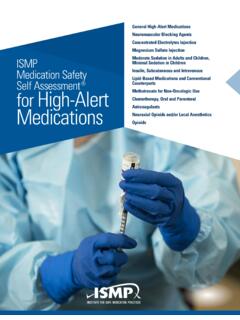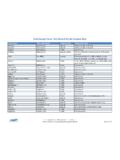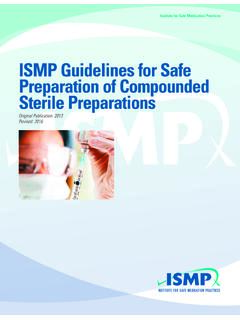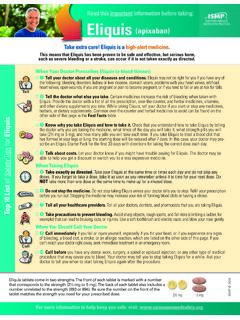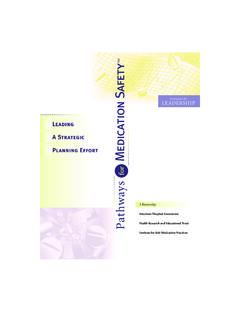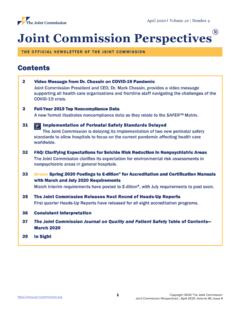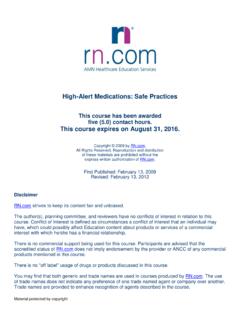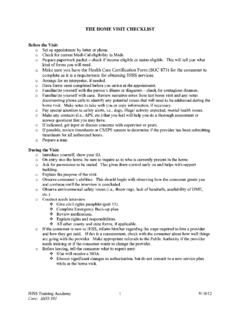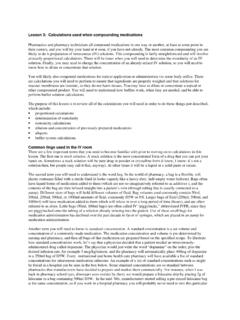Transcription of ISMP List of High-Alert Medications
1 EPINEPH rine, IM, subcutaneous epoprostenol ( , Flolan), IVinsulin U-500 (special emphasis*)magnesium sulfate injectionmethotrexate, oral, nononcologic usenitroprusside sodium for injectionopium tinctureoxytocin, IVpotassium chloride for injection concentratepotassium phosphates injectionpromethazine injection vasopressin, IV and intraosseous*All forms of insulin, subcutaneous and IV, areconsidered a class of High-Alert Medications . InsulinU-500 has been singled out for special emphasis tobring attention to the need for distinct strategies toprevent the types of errors that occur with thisconcentrated form of agonists, IV ( , EPINEPH rine, phenylephrine, norepinephrine)adrenergic antagonists, IV ( , propranolol, metoprolol, labetalol)anesthetic agents, general, inhaled and IV ( , propofol, ketamine)antiarrhythmics, IV ( , lidocaine, amiodarone) antithrombotic agents, including.
2 Anticoagulants ( , warfarin, low molecular weight heparin, unfractionatedheparin) direct oral anticoagulants and factor Xa inhibitors ( , dabigatran, rivaroxaban,apixaban, edoxaban, betrixaban, fondaparinux)direct thrombin inhibitors ( , argatroban, bivalirudin, dabigatran)glycoprotein IIb/IIIa inhibitors ( , eptifibatide) thrombolytics ( , alteplase, reteplase, tenecteplase)cardioplegic solutionschemotherapeutic agents, parenteral and oraldextrose, hypertonic, 20% or greaterdialysis solutions, peritoneal and hemodialysisepidural and intrathecal medicationsinotropic Medications , IV ( , digoxin, milrinone)insulin, subcutaneous and IVliposomal forms of drugs ( , liposomal amphotericin B) and conventional counterparts( , amphotericin B desoxycholate)moderate sedation agents, IV ( , dexmedetomidine, midazolam, LORazepam)moderate and minimal sedation agents, oral, for children ( , chloral hydrate,midazolam, ketamine [using the parenteral form])opioids, including.
3 IVoral (including liquid concentrates, immediate- and sustained-release formulations)transdermalneuromuscular blocking agents ( , succinylcholine, rocuronium, vecuronium)parenteral nutrition preparations sodium chloride for injection, hypertonic, greater than concentrationsterile water for injection, inhalation and irrigation (excluding pour bottles) in containersof 100 mL or moresulfonylurea hypoglycemics, oral ( , chlorproPAMIDE, glimepiride, glyBURIDE,glipiZIDE, TOLBUT amide)Classes/Categories of MedicationsSpecific MedicationsBased on error reports submitted to theISMP National medication ErrorsReporting Program (ISMP MERP), reportsof harmful errors in the literature, studiesthat identify the drugs most ofteninvolved in harmful errors, and input frompractitioners and safety experts, ISMP created and periodically updates a list ofpotential High-Alert Medications .
4 DuringJune and July 2018, practitionersresponded to an ISMP survey designed toidentify which Medications were mostfrequently considered High-Alert medica-tions. Further, to assure relevance andcompleteness, the clinical staff at ISMPand members of the ISMP advisory boardwere asked to review the potential list of Medications and medicationcategories reflects the collective thinkingof all who provided ISMP 2018. Permission is granted to reproduce material with proper attribution for internal use within healthcare organizations. Other reproduction is prohibitedwithout written permission from ISMP. Report medication errors to the ISMP National medication Errors Reporting Program (ISMP MERP) at List of High-Alert Medicationsin Acute Care SettingsAbbreviation definitions: IV intravenous IM intramuscularigh- alert Medications are drugs that bear a heightened risk of causing significant patient harm when they are used in error.
5 Although mistakesmay or may not be more common with these drugs, the consequences of an error are clearly more devastating to patients. We hope you willuse this list to determine which Medications require special safeguards to reduce the risk of errors. This may include strategies such as standardizingthe ordering, storage, preparation, and administration of these products; improving access to information about these drugs; limiting access to High-Alert Medications ; using auxiliary labels; employing clinical decision support and automated alerts; and using redundancies such as automated orindependent double checks when necessary. (Note: manual independent double checks arenot always the optimal error-reduction strategy and may not be practical for all of themedications on the list.)
6 H
